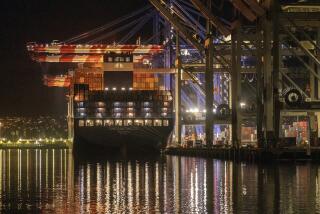Re-enacting a past where cattle were king in the South Bay and California’s president lived in Mexico
- Share via
In October 1846, before the wall or detention centers or the Border Patrol, Los Angeles was known as El Pueblo de Los Ángeles in the vast and remote Mexican territory of Alta California. And its former mayor, Manuel Dominguez, was intent on keeping invaders at bay.
It was the time of the Mexican-American War, and the invaders were U.S. Marines marching 380 strong toward the pueblo from their port in San Pedro, right through Dominguez’s ranch — 75,000 acres of dusty grazing land that covered a region now populated by communities from the Palos Verdes Peninsula to Compton.
The ensuing battle will be re-enacted Oct. 5 and 6, during the Dominguez Rancho Adobe Museum’s 12th commemoration of the event.
Dominguez was a prominent and wealthy Californio, a Californian of Spanish ancestry, who sometimes chafed at the dictates from Mexico City, a centralized government too far removed to understand the realities of a rancher’s life in the rugged north. Nonetheless, said historian Luis Fernandez, executive director of the Dominguez Rancho Adobe Museum, Dominguez and his fellow Californios did not want to be overtaken by the U.S. either, so they hatched a plan to repel the invaders 19 miles south of the pueblo near Dominguez’s adobe.
Those advancing were well-armed Marines. The Californios numbered only 50 landowners and local recruits who had some crucial advantages: They all had horses and intimate knowledge of the dry, hilly terrain. They also had a secret weapon — a small cannon hidden away by a Californio named Clara Cota de Reyes.
Using their horses, the Californios swiftly dragged the cannon from one hillside to another, firing from different locations to make the Marines believe they were outgunned.
The ruse worked. After two days of fighting — on Oct. 8 and 9, 1846 — the Marines retreated with five dead. The victorious Californios suffered no casualties, Fernandez said.
Of course, two months later, the Marines returned with nearly triple their number to take control of the pueblo, but they came in via San Diego, keeping their distance from the Dominguez rancho.
Ultimately, U.S. troops took over Mexico City as well, and on Feb. 2, 1848, won the war, paying Mexico $1.5 million in reparations and taking roughly twice that amount of Mexican debt in exchange for Alta California, a region that became the states of California, Arizona, New Mexico, Colorado and Nevada.
Dominguez went on to help craft California’s Constitution in 1849. His six daughters inherited most of his land, which he had inherited from an uncle, Juan Jose Dominguez, a soldier in the Portola expedition; it was the first Spanish land grant in California, today encompassing Carson, Compton, Gardena, Harbor City, Lomita, the Palos Verdes Peninsula, Redondo Beach, San Pedro, Torrance and Wilmington, as well as unincorporated Rancho Dominguez, where the 14-room home Dominguez built for his new wife, Maria Engracia Cota, houses the Dominguez Rancho Adobe Museum, a private organization devoted to preserving the family’s legacy and the region’s early history.
The museum’s family-friendly re-enactment of the Battle of Dominguez Hills involves about 50 volunteers, who will be in character both days, to answer questions about whom they portray and why they were fighting. The event also features activities from the era. Visitors can tour Dominguez’s 14-room house, built in 1827 when he married Maria Engracia de Cota, and try their hand at making adobe bricks, the most viable building material of the time, as well as cattle roping (on dummy cows) and tortilla making.
Children can make corn husk dolls and pan for gold, although most of the gold mining in California happened farther north. The connection to Dominguez? He sent his cattle north to sell to prospectors, Fernandez said, part of the savvy business crowd that mined the miners to make their money.
The re-enactment tries to be authentic, but it can’t include Clara Cota de Reyes’ cannon, Fernandez said. The original got carted across the country, where it’s on display — ironically enough — at the U.S. Naval Academy Museum in Annapolis, Md.
Re-enactment of the 1846 Battle of Dominguez Hills
Where: Dominguez Rancho Adobe Museum, 18127 S. Alameda St., Rancho Dominguez
When: 10 a.m. to 4 p.m. Oct. 5-6. Re-enactments at noon and 3 p.m. Oct. 5, 11:30 a.m. and 2:30 p.m. Oct. 6.
Info: Free admission and parking. Food available for purchase. dominguezrancho.org
More to Read
Sign up for The Wild
We’ll help you find the best places to hike, bike and run, as well as the perfect silent spots for meditation and yoga.
You may occasionally receive promotional content from the Los Angeles Times.











